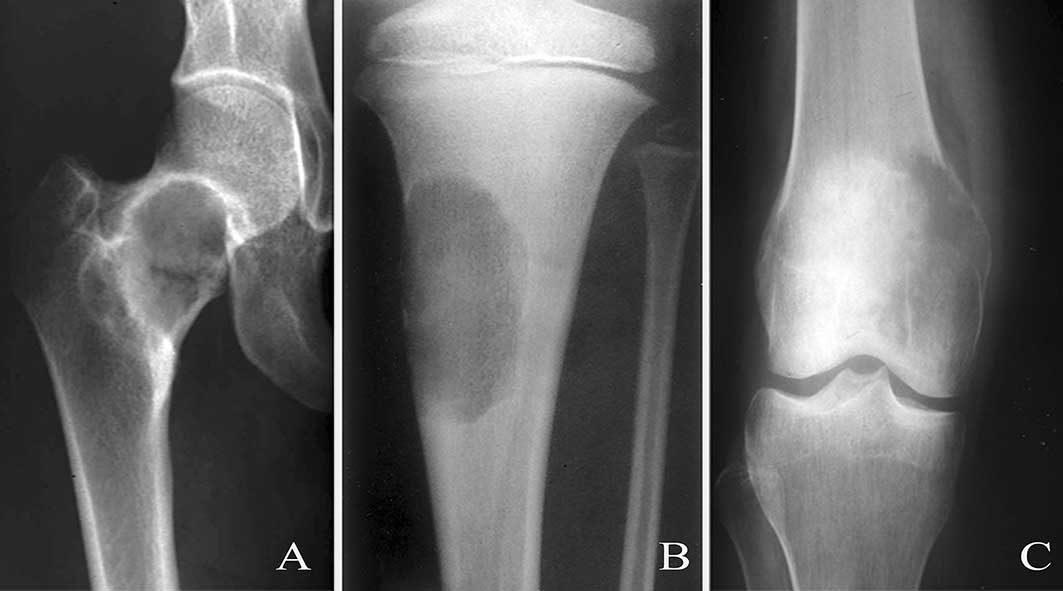Bone tumors
Bone tumors are an abnormal growth of cells within the bone that may be benign or malignant (cancerous). The cause of bone tumors is unknown. They often arise in areas of rapid growth. Possible causes include inherited mutations, trauma and radiation, but in most cases no specific cause is found for bone tumors. The cause of bone tumors is unknown. They often arise in areas of rapid growth. Possible causes include inherited mutations, trauma and radiation, but in most cases no specific cause is found.
Bone tumors may be benign or malignant. Osteochondromas are the most common benign bone tumors and occur most often in people between the ages of 10 and 20. Some benign bone tumors go away on their own and do not require treatment. These benign tumors are monitored periodically by X-ray.
Malignant bone tumors occur as a primary bone tumor or as metastasis (cancer spread from another area of the body). Primary bone tumors are rare (less than 1% of all malignant tumors) and are most common in young men. Malignant bone tumors include osteosarcomas, Ewing’s sarcoma, fibrosarcoma, and chondrosarcoma. The most common cancers that spread to the bone are cancer of the breast, lung, prostate, kidney, and thyroid. These forms of cancer usually affect older people.
Bone cancer was once prevalent among individuals who painted radium on watch faces (to produce glow-in-the-dark dials), a practice that was abandoned in the middle of the 20th century. The painter would ‘tip’ the brush with their tongue (in order to produce fine work) and absorb minute amounts of radium, which deposited in the bone and caused cancer. The incidence of bone cancer is also increased in families with familial cancer syndromes. The incidence of bone cancer in children is approximately 5 cases per million children each year.
Benign bone tumors may not require treatment but may be assessed periodically to check for progression or regression. Surgical removal may be necessary. Treatment for malignant tumors that have spread to bone depends upon the primary tissue or organ involved. Radiation therapy with chemotherapy or hormone therapy is commonly used. Primary malignant tumors of bone (tumors that start in the bone) are rare and require treatment at centers with experience treating these cancers. After biopsy, a combination of chemotherapy and surgery is usually necessary. Radiation therapy may be needed before or after surgery.
Chondroblastoma
Chondroblastoma is a rare type of bone tumor that can affect people of all ages. It is usually found in the epiphyses of long bones before epiphyseal closure. They are found in the secondary centers of ossification and account for 5% of benign bone tumors. Tumors are most likely found in the humerus, followed by the femur and then the tibia. Chondroblastomas may be found in association with aeurysmal bone cysts. Males are slightly more at risk and the diagnosis is usually made in persons from 5 to 25 years old. Chondroblastoma is, however, most common in children and young adults between the ages of 10 and 20 years. This type of tumor is also more common in males than females.
Enchondroma
An enchondroma is a type of benign (non-cancerous) bone tumor that originates from cartilage. Cartilage is the specialized, gristly connective tissue that is present in adults and the tissue from which most bones develop. Cartilage plays an important role in the growth process. There are many different types of cartilage that are present throughout the body. An enchondroma most often affects the cartilage that lines the inside of the bones. The bones most often involved with this benign tumor are the miniature long bones of the hands and feet. It may, however, also involve other bones such as the femur (thighbone), humerus (upper arm bone), or tibia (one of the two lower leg bones).
Osteochondroma
Also called osteocartilaginous exostoses, osteochondroma is an overgrowth of cartilage and bone near the end of the bone near the growth plate. This type of overgrowth can occur in any bone where cartilage eventually forms bone. Most commonly, it affects the long bones in the leg, the pelvis, or scapula (shoulder blade). Osteochondromas are most often seen in the second or third decade of life, although they are thought to be congenital lesions arising from displaced or aberrant growth plate cartilage. They may also arise in children with open growth plates who have been irradiated. What a child feels depends on the size and location of the tumor. In general, they are hard and are part of the bone.
Giant cell tumor
A giant cell tumor is one that is made up of a large number of benign (non-cancerous) cells that form an aggressive tumor – usually near the end of the bone near a joint. The location of a giant cell tumor is often in the knee, but can also involve the bones of the arms and the legs, or the flat bones such as the sternum (breastbone) or pelvis. The tumor is often coated by new bony growth. It causes pain, restricts movement, and is usually cancerous. Giant cell tumors most often occur when skeletal bone growth is complete. They are most prevalent after age 20 and are rare after age 55.
 Parsi Teb Physical and Mental Health Journal
Parsi Teb Physical and Mental Health Journal 



